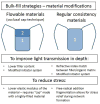Polymer-Based Direct Filling Materials
- PMID: 28886766
- PMCID: PMC5679066
- DOI: 10.1016/j.cden.2017.06.002
Polymer-Based Direct Filling Materials
Abstract
After a brief review of current restorative materials and classifications, this article discusses the latest developments in polymer-based direct filling materials, with emphasis on products and studies available in the last 10 years. This will include the more recent bulk fill composites and self-adhesive materials, for which clinical evidence of success, albeit somewhat limited, is already available. The article also introduces the latest cutting edge research topics on new materials for composite restorations, and an outlook for the future of how those may help to improve the service life of dental composite restorations.
Keywords: Caries; Clinical longevity; Dental composites; Polymerization.
Copyright © 2017 Elsevier Inc. All rights reserved.
Figures



References
-
- Karaman E, Keskin B, Inan U. Three-year clinical evaluation of class II posterior composite restorations placed with different techniques and flowable composite linings in endodontically treated teeth. Clinical Oral Investigations. 2016:1–8. - PubMed
-
- Schwendicke F, Krüger H, Schlattmann P, Paris S. Restoration outcomes after restoring vital teeth with advanced caries lesions: a practice-based retrospective study. Clinical Oral Investigations. 2016;20:1675–1681. - PubMed
-
- Pfeifer CS, Ferracane JL, Sakaguchi RL, Braga RR. Factors affecting photopolymerization stress in dental composites. Journal of Dental Research. 2008;87:1043–1047. - PubMed
-
- Baracco B, Fuentes MV, Ceballos L. Five-year clinical performance of a silorane- vs a methacrylate-based composite combined with two different adhesive approaches. Clinical Oral Investigations. 2016;20:991–1001. - PubMed
Publication types
MeSH terms
Substances
Grants and funding
LinkOut - more resources
Full Text Sources
Other Literature Sources

